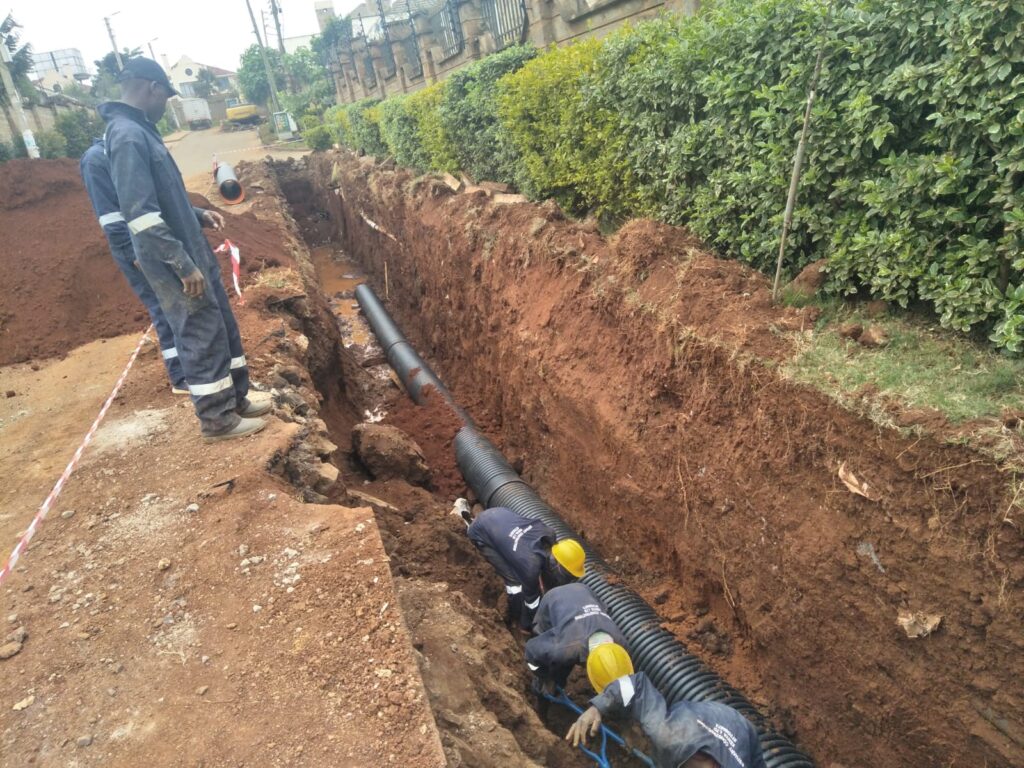
Constructing drainage lines in Kenya, whether for stormwater or wastewater management, involves a systematic process that includes planning, design, excavation, installation, and testing. Proper drainage is essential to prevent flooding, erosion, and environmental issues. Here are the general steps for constructing drainage lines in Kenya:
- Preliminary Planning and Design:
- Identify the need for a new drainage system or an extension of an existing one based on local conditions, rainfall patterns, and urban development.
- Conduct a preliminary survey and assessment of the area to determine the optimal route and size of the drainage lines.
- Consider environmental and regulatory factors, such as avoiding sensitive habitats, complying with local building codes, and obtaining the necessary permits.
- Detailed Design:
- Engage a team of engineers and designers to create detailed plans and specifications for the drainage lines. This includes determining pipe size, materials, alignment, and slope.
- Design the drainage system to handle expected rainfall and runoff while considering soil conditions.
- Specify the type of pipes to be used, such as PVC, concrete, or corrugated metal, based on factors like soil conditions and expected flow rates.
- Design catch basins, manholes, and other drainage structures as needed.
- Permitting and Regulatory Compliance:
- Obtain all required permits and approvals from local, state, or national authorities.
- Ensure compliance with environmental regulations and assess potential environmental impacts, which may involve mitigation measures.
- Site Preparation:
- Clear the construction site of any vegetation or obstacles.
- Mark the alignment of the drainage lines on the ground using survey markers.
- Excavation:
- Excavate trenches along the planned alignment of the drainage lines. The depth and width of the trenches should match the design specifications.
- Ensure proper safety measures are in place for workers and nearby residents.
- Installation:
- Lay the drainage pipes in the excavated trenches, ensuring they have the correct slope and alignment.
- Properly connect the pipes using appropriate connectors and sealants.
- Construct catch basins, manholes, and other drainage structures as specified in the design.
- Backfill the trenches with suitable materials, compacting them in layers to prevent settling.
- Testing:
- Perform tests to check for leaks and verify the drainage system’s functionality. Common tests include water testing and visual inspections.
- Ensure that all connections, joints, and seals are watertight.
- Final Inspection:
- Have local authorities or regulatory agencies conduct a final inspection to verify compliance with design and safety standards.
- Site Restoration:
- Restore the construction site by replacing topsoil, landscaping, and repairing any surface damage.
- Ensure that roadways, sidewalks, or any other infrastructure disrupted during construction are properly repaired and restored.
- Maintenance and Operation:
- After construction, the drainage system is typically handed over to the relevant utility or municipal authority responsible for its operation and maintenance.
It’s crucial to involve experienced engineers, contractors, and skilled workers in drainage line construction to ensure the project’s success and long-term functionality. Regular maintenance and inspections are necessary to keep drainage lines in good working condition and to prevent flooding and erosion in the are